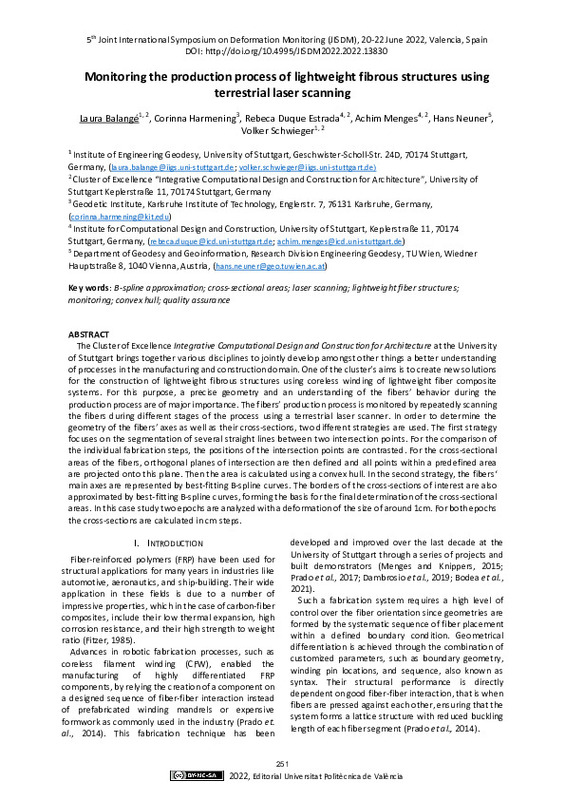JavaScript is disabled for your browser. Some features of this site may not work without it.
Buscar en RiuNet
Listar
Mi cuenta
Estadísticas
Ayuda RiuNet
Admin. UPV
Monitoring the production process of lightweight fibrous structures using terrestrial laser scanning
Mostrar el registro sencillo del ítem
Ficheros en el ítem
| dc.contributor.author | Balangé, Laura
|
es_ES |
| dc.contributor.author | Harmening, Corinna
|
es_ES |
| dc.contributor.author | Duque Estrada, Rebeca
|
es_ES |
| dc.contributor.author | Menges, Achim
|
es_ES |
| dc.contributor.author | Neuner, Hans
|
es_ES |
| dc.contributor.author | Schwieger, Volker
|
es_ES |
| dc.date.accessioned | 2023-03-07T09:00:22Z | |
| dc.date.available | 2023-03-07T09:00:22Z | |
| dc.date.issued | 2023-01-27 | |
| dc.identifier.isbn | 9788490489796 | |
| dc.identifier.uri | http://hdl.handle.net/10251/192383 | |
| dc.description.abstract | [EN] The Cluster of Excellence Integrative Computational Design and Construction for Architecture at the University of Stuttgart brings together various disciplines to jointly develop amongst other things a better understanding of processes in the manufacturing and construction domain. One of the cluster’s aims is to create new solutions for the construction of lightweight fibrous structures using coreless winding of lightweight fiber composite systems. For this purpose, a precise geometry and an understanding of the fibers’ behavior during the production process are of major importance. The fibers’ production process is monitored by repeatedly scanning the fibers during different stages of the process using a terrestrial laser scanner. In order to determine the geometry of the fibers’ axes as well as their cross-sections, two different strategies are used. The first strategy focuses on the segmentation of several straight lines between two intersection points. For the comparison of the individual fabrication steps, the positions of the intersection points are contrasted. For the cross-sectional areas of the fibers, orthogonal planes of intersection are then defined and all points within a predefined area are projected onto this plane. Then the area is calculated using a convex hull. In the second strategy, the fibers‘ main axes are represented by best-fitting B-spline curves. The borders of the cross-sections of interest are also approximated by best-fitting B-spline curves, forming the basis for the final determination of the cross-sectional areas. In this case study two epochs are analyzed with a deformation of the size of around 1cm. For both epochs the cross-sections are calculated in cm steps. | es_ES |
| dc.description.sponsorship | The research published in this article is supported by the Deutsche Forschungsgemeinschaft (DFG, German Research Foundation) under Germany’s Excellence Strategy – EXC 2120/1 – 390831618. The authors cordially thank the DFG. A part of the research was realized within a one-month research stay of the second author at the University of Stuttgart within the IntCDC incoming programme. | es_ES |
| dc.format.extent | 9 | es_ES |
| dc.language | Inglés | es_ES |
| dc.publisher | Editorial Universitat Politècnica de València | es_ES |
| dc.relation.ispartof | 5th Joint International Symposium on Deformation Monitoring (JISDM 2022) | |
| dc.rights | Reconocimiento - No comercial - Compartir igual (by-nc-sa) | es_ES |
| dc.subject | B-spline approximation | es_ES |
| dc.subject | Cross-sectional areas | es_ES |
| dc.subject | Laser scanning | es_ES |
| dc.subject | Lightweight fiber structures | es_ES |
| dc.subject | Monitoring | es_ES |
| dc.subject | Convex hull | es_ES |
| dc.subject | Quality assurance | es_ES |
| dc.title | Monitoring the production process of lightweight fibrous structures using terrestrial laser scanning | es_ES |
| dc.type | Capítulo de libro | es_ES |
| dc.type | Comunicación en congreso | es_ES |
| dc.identifier.doi | 10.4995/JISDM2022.2022.13830 | |
| dc.relation.projectID | info:eu-repo/grantAgreement/DFG//390831618 | es_ES |
| dc.rights.accessRights | Abierto | es_ES |
| dc.description.bibliographicCitation | Balangé, L.; Harmening, C.; Duque Estrada, R.; Menges, A.; Neuner, H.; Schwieger, V. (2023). Monitoring the production process of lightweight fibrous structures using terrestrial laser scanning. En 5th Joint International Symposium on Deformation Monitoring (JISDM 2022). Editorial Universitat Politècnica de València. 251-259. https://doi.org/10.4995/JISDM2022.2022.13830 | es_ES |
| dc.description.accrualMethod | OCS | es_ES |
| dc.relation.conferencename | 5th Joint International Symposium on Deformation Monitoring | es_ES |
| dc.relation.conferencedate | Junio 20-22, 2022 | es_ES |
| dc.relation.conferenceplace | València, España | es_ES |
| dc.relation.publisherversion | http://ocs.editorial.upv.es/index.php/JISDM/JISDM2022/paper/view/13830 | es_ES |
| dc.description.upvformatpinicio | 251 | es_ES |
| dc.description.upvformatpfin | 259 | es_ES |
| dc.type.version | info:eu-repo/semantics/publishedVersion | es_ES |
| dc.relation.pasarela | OCS\13830 | es_ES |
| dc.contributor.funder | Deutsche Forschungsgemeinschaft | es_ES |








